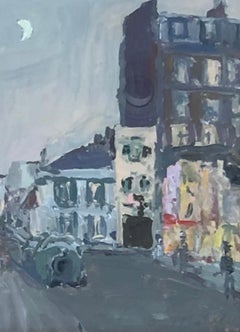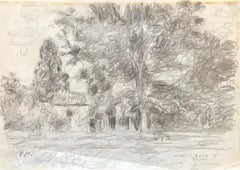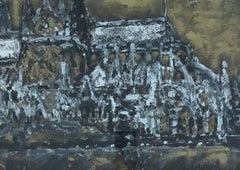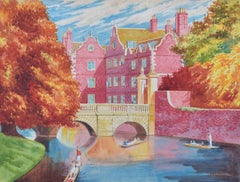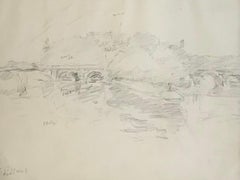Paul Mathey Drawings and Watercolor Paintings
French, 1844-1929
Paul Albert Mathey is the son of Charles and Elisa Beaujon. Orphaned at 14, he was taken in by an uncle and spent his childhood in New York. In 1931, he married Claire-Lise Monnier, a painter like him. They have exhibited together several times.
Between 1905 and 1910, he took evening classes at the Art Student's League in New York. From 1910 to 1916, he attended the School of Fine Arts in Geneva and was a pupil of Barthélemy Menn. During this period, he received several awards and mentions. In 1916-1917, he worked with Ferdinand Hodler. In 1918, he became a member of the Society of Swiss Painters, Sculptors and Architects (he participated in all of its exhibitions until 1967) and of the Gottfried Keller Foundation (1954-1961). He mainly painted landscapes and still lifes. He also made some theater sets in Geneva. In 1967, he became a Knight of the Order of Arts and Letters. A large part of his works can be found at the Monnier Foundation in Cartigny.to
1
3
Overall Width
to
Overall Height
to
3
2
1
2
2
1
1
1
2
2
1
1
18
930
406
282
279
2
1
3
Artist: Paul Mathey
Half Moon
By Paul Mathey
Located in Genève, GE
Work on paper
Golden wooden frame with glass pane
46.7 x 39.5 x 3 cm
This work presents a nocturnal urban scene, striking with its mysterious and dreamlike atmosphere. On the canva...
Category
Early 20th Century Paul Mathey Drawings and Watercolor Paintings
Materials
Watercolor
$1,007
Landscape by Paul Mathey - Pencil on paper 30x43 cm
By Paul Mathey
Located in Geneva, CH
Work on paper
Category
Mid-20th Century Academic Paul Mathey Drawings and Watercolor Paintings
Materials
Crayon
$160 Sale Price
20% Off
Composition of Notre Dame, Paris
By Paul Mathey
Located in Genève, GE
Work on watercolor paper
Golden wooden frame with glass pane
51 x 63 x 3 cm
This artwork offers a striking interpretation of an urban landscape, enveloped in a palette of earthy, m...
Category
Early 20th Century Paul Mathey Drawings and Watercolor Paintings
Materials
Gouache
Related Items
Gouache of St John's College, Cambridge
Located in London, GB
To see our other Oxford and Cambridge pictures, scroll down to "More from this Seller" and below it click on "See all from this Seller" - or send us a message if you cannot find the ...
Category
20th Century Realist Paul Mathey Drawings and Watercolor Paintings
Materials
Gouache
A Summer Road - Original Watercolor by Armin Guther - 1997
By Armin Guther
Located in Roma, IT
A Summer Road is an original colored watercolor realized in 1997 by Armin Guther.
Good conditions. Includes passepartout (50 x 60 cm).
The artwork is hand-signed and dated on the l...
Category
1980s Contemporary Paul Mathey Drawings and Watercolor Paintings
Materials
Watercolor
$415
H 14.57 in W 9.85 in D 0.08 in
19th C. American Impressionist Gouache of Colorado Mountains in Spring
By Charles Partridge Adams
Located in Denver, CO
This original circa 1910s plein air field study by renowned Colorado landscape artist Charles Partridge Adams captures the serene beauty of the Rocky Mountains in a masterful display...
Category
1910s American Impressionist Paul Mathey Drawings and Watercolor Paintings
Materials
Gouache
$1,880
H 13.75 in W 17.75 in D 0.75 in
Family Farm in France
Located in London, GB
'Family Farm in France', gouache on art paper, by Michel Debiève (circa 1970s). An extremely endearing depiction of a French family farm, the delight is...
Category
1970s Modern Paul Mathey Drawings and Watercolor Paintings
Materials
Paper, Gouache
Mid Century Bermudian Watercolor by Alfred Birdsey
By Alfred Birdsey
Located in Palm Beach, FL
Alfred Birdsey was a renowned English born Bermudian painter. Here is a watercolor representative of his confident loose style and familiar bayscape subjects. Signed in the lower rig...
Category
Mid-20th Century Abstract Expressionist Paul Mathey Drawings and Watercolor Paintings
Materials
Watercolor
Valley View with Pines and Distant Peaks, Sierra Nevada (Possibly Yosemite)
By Carl Oscar Borg
Located in Stockholm, SE
This luminous gouache captures a majestic mountain vista, likely set in California’s Sierra Nevada (possibly Yosemite). Two broad granite peaks with sunlit faces dominate the backgro...
Category
Early 20th Century Impressionist Paul Mathey Drawings and Watercolor Paintings
Materials
Paper, Gouache
$3,438
H 11.03 in W 9.06 in
'Chinatown San Francisco at Twilight', French School (circa 1950s)
Located in London, GB
'Chinatown San Francisco at Twilight', ink and gouache, diptych on card stock, French School (circa 1950s). This artwork was discovered in Paris, France. The unnamed artist skilfully captured that magical moment at dusk when light is at its most beautiful. The scene is Chinatown, San Francisco in the 1950s. The Far East Café, depicted in this artwork was established in 1920. It is the oldest banquet-style Chinese restaurant in the city. Of course, Chinese cuisine in large cities in America has since moved on from the chop suey...
Category
Mid-20th Century Paul Mathey Drawings and Watercolor Paintings
Materials
Ink, Gouache
$1,646
H 16.15 in W 25.2 in
Early 19th Century English watercolour of woodland near Croxdale Hall
Located in Harkstead, GB
A very attractive and meticulously executed view of a rocky landscape within the woods dating to 1823. This would suit a library or study with its muted tones and skifull draughtsmanship.
William Nicholson (1781-1844)
Near Croxdale Hall
Signed with initials and inscribed with title and date 1823
Pen, ink and grey wash
11 x 8 inches, image only
17 x 13 inches without frame
The portrait-painter and etcher William Nicholson was born in Ovingham-on-Tyne, Northumberland, on Christmas Day 1781. His family transferred to Newcastle when his father was appointed Headmaster of the city's Grammar School. At an early age, though, Nicholson appears to have moved to Hull where he made his artistic debut, painting miniatures of officers garrisoned there. He was almost entirely self-taught, learning his craft through the close study of artworks in private and public galleries. He subsequently returned to Newcastle where he received many commissions to paint portraits of the old families of Northumberland. In 1808, he began to exhibit at the Royal Academy, continuing to do so until 1822. By 1814, Nicholson, whose mother was a Scot, had moved to Edinburgh where he set up as a miniaturist and painter in oils. Soon, however, he began to specialize in watercolour portraits. Early subjects included the actor Daniel Terry and the poet and novelist James Hogg. In 1818 he began to publish a series of Portraits of Eminent Scotsmen, etched from his own portraits and those of other painters. Besides Scott and Hogg, the subjects included the writers Robert Burns, John Wilson ('Christopher North'), and Lord Jeffrey, the painters Sir Henry Raeburn, the divines Alexander Carlyle and Alexander Cameron, the engineer James Watt, the architect John Playfair, and the song-collector and composer George Thomson...
Category
Early 19th Century Academic Paul Mathey Drawings and Watercolor Paintings
Materials
Paper, Watercolor, Ink, Pen
$411 Sale Price
20% Off
H 11 in W 8 in D 1 in
Notre Dame de Paris II
By Lucien Génin
Located in London, GB
'Notre Dame de Paris II', gouache on paper, by Lucien Génin (circa 1930s). One of two paintings of Notre Dame by this artist held by our gallery, it is also an absolutely charming and now, historic depiction from the 1930s, of the most famous cathedral in France. This version uses more exaggerated brushstrokes with strong colours attesting to its expressionist roots. Notre Dame is one of the most widely recognised symbols of the city of Paris and the French nation. As the cathedral of the Archdiocese of Paris, Notre-Dame contains the cathedra of the Archbishop of Paris. Approximately 12 million people visit Notre-Dame annually, making it the most visited monument in the city. While undergoing renovation and restoration, the roof of Notre-Dame caught fire on the evening of 15 April 2019. Burning for around 15 hours, the cathedral sustained serious damage. The government of France hopes the reconstruction can be completed by Spring 2024, in time for the opening of the 2024 Summer Olympics in Paris. Unlike the actual cathedral, this artwork is in good condition, is newly framed and glazed and signed by the artist in the lower right hand corner. Upon request a video may be provided.
About the Artist: After the devastation of the First World War, Lucien Génin (1894 - 1953) left his provincial home in the autumn of 1919 to find his fortune among the lively Parisians in the heart of Montmartre. Génin befriended the painters Frank Will, Gen Paul, Émile Boyer, Marcel Leprin...
Category
1930s Expressionist Paul Mathey Drawings and Watercolor Paintings
Materials
Paper, Gouache
Pair of Mid Century Bermudian Watercolors by Alfred Birdsey
By Alfred Birdsey
Located in Palm Beach, FL
Alfred Birdsey was a renowned English born Bermudian painter. Here are a pair of watercolors representative of his confident loose style and familiar bayscape subjects. Signed in the...
Category
Late 20th Century Abstract Expressionist Paul Mathey Drawings and Watercolor Paintings
Materials
Watercolor
$4,750
H 23.5 in W 29.5 in D 1 in
untitled (Yellow Adobe Building with Bell)
By William Grauer
Located in Fairlawn, OH
Untitled (Mexican Village)
Ink and watercolor on paper, c. 1960
Estate Stamp Lower Left
Provenance: estate of the Artist
Condition: Excelleent
Image/Sheet size; 8 3/4 x 5 3/4 inches
...
Category
20th Century Paul Mathey Drawings and Watercolor Paintings
Materials
Ink, Watercolor
Antique Watercolor of Steam Yacht Akela
Located in Palm Beach, FL
Historical antique watercolor of noted steam yacht Akela built in 1899 in US, converted for WWI service in 1917 and returned to owner in 1919. Signed Bond in the lower right and fram...
Category
Early 20th Century Realist Paul Mathey Drawings and Watercolor Paintings
Materials
Watercolor
Previously Available Items
Pont Neuf, Geneva
By Paul Mathey
Located in Geneva, CH
Work on paper
Silver wooden frame with glass pane
42,5 x 50 x 3 cm
Category
Mid-20th Century Academic Paul Mathey Drawings and Watercolor Paintings
Materials
Pencil
Paul Mathey drawings and watercolor paintings for sale on 1stDibs.
Find a wide variety of authentic Paul Mathey drawings and watercolor paintings available for sale on 1stDibs. You can also browse by medium to find art by Paul Mathey in paint, watercolor, crayon and more. Not every interior allows for large Paul Mathey drawings and watercolor paintings, so small editions measuring 9 inches across are available. Customers who are interested in this artist might also find the work of Jean Baptiste Édouard Detaille, Robert Ladou, and Georges Conrad. Paul Mathey drawings and watercolor paintings prices can differ depending upon medium, time period and other attributes. On 1stDibs, the price for these items starts at $100 and tops out at $864, while the average work can sell for $809.
Artists Similar to Paul Mathey
Jean Baptiste Édouard Detaille
